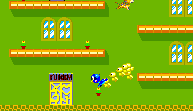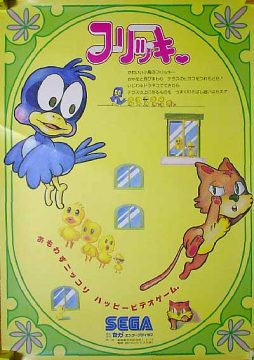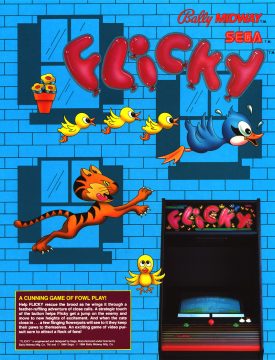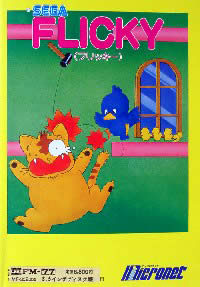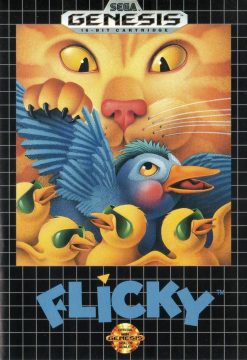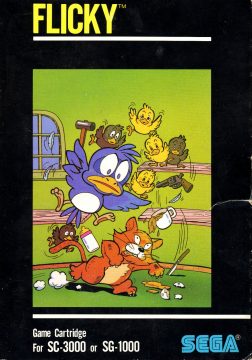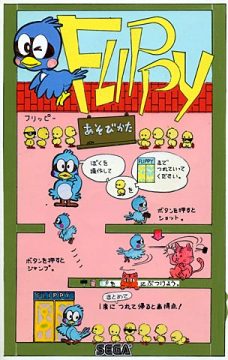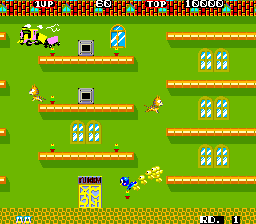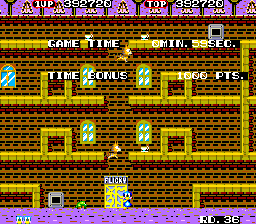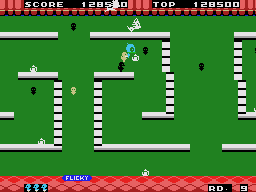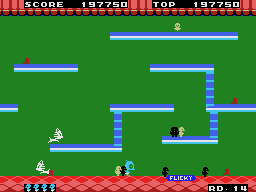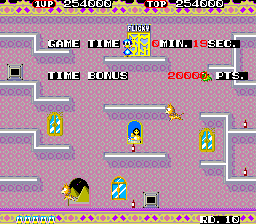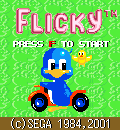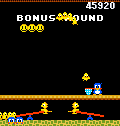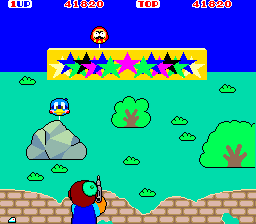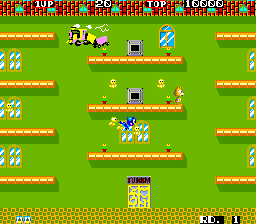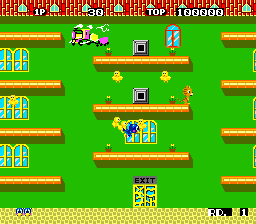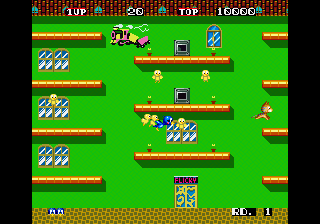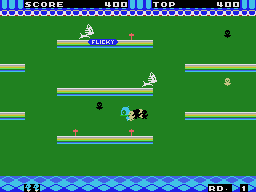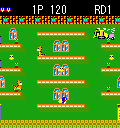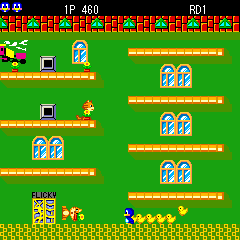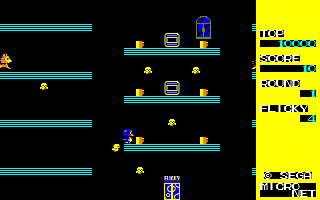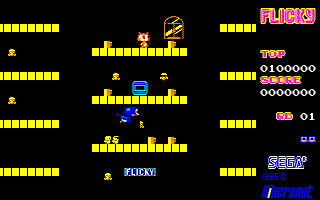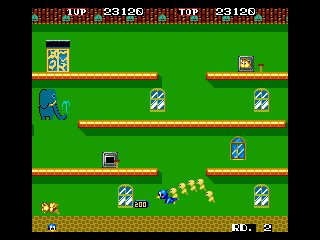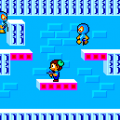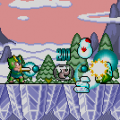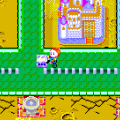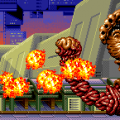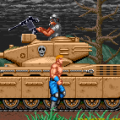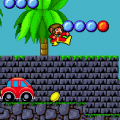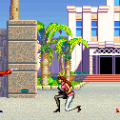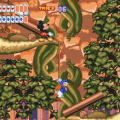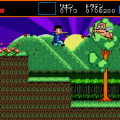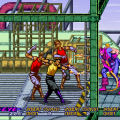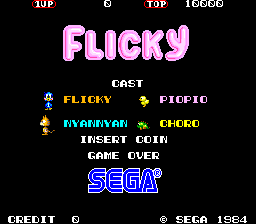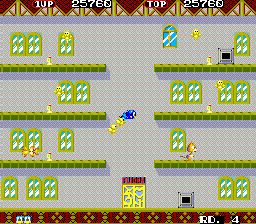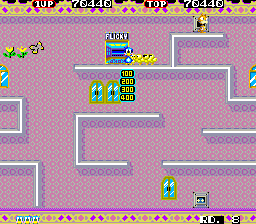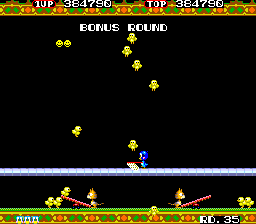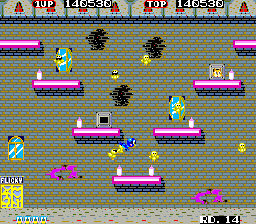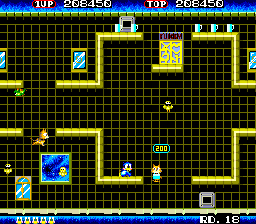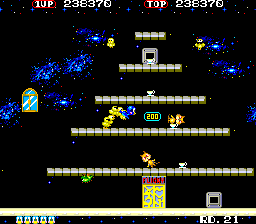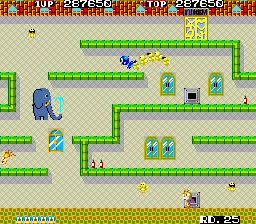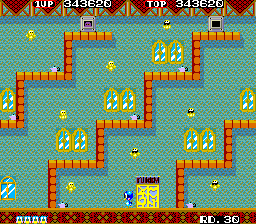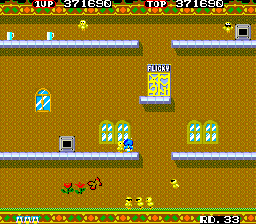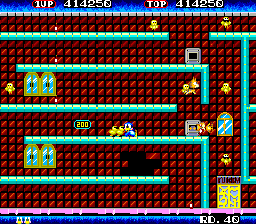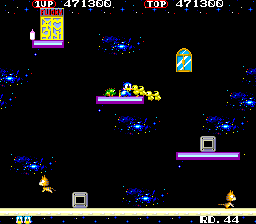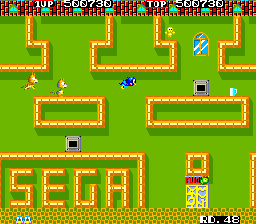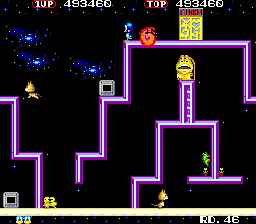Conceived by Yoji Ishii (who later created Fantasy Zone before being promoted away from hands-on design and working as a producer on a good chunk of Sega’s Saturn lineup), Flicky was one of Sega’s more successful early attempts at a game with personality. The cute little platformer featured adorable character designs by long time customer service staff member Yoshiki Kawasaki (also responsible for the art in Spatter and Ninja Princess), and was originally meant to be called “Flippy,” until someone discovered an overseas trademark issue.
Gather up Piopio! Defeat Nyannyan! Take Piopio home!
In Flicky, players take control of the eponymous bird, whose fledglings, the “Piopio” (named by the Japanese onomatopoeia for the sound they make), have gone astray inside an apartment building. The task is to gather them all and bring them to the exit, avoiding the hungry “Nyannyan” (cats) and – oddly – the iguana Choro. This isn’t as easy as it sounds: Being a bird, Flicky is subject to the floaty, inertia-heavy jump physics that later made Super Mario Bros. famous (only here they sort of make sense), and bounces away from vertical obstacles, rendering precision jumps all but impossible. Although all stages only take place on a single wraparound screen, the view keeps scrolling with Flicky in the center. The illusion of larger stages only lasts for a very short while, the disorientation quite a bit longer.
The Piopio follow their mother in a line, and the longer it gets, the easier it becomes for the Nyannyan to jump in between and disperse them in all directions. While the regular Piopio stay close to where they got separated, their sunglass-wearing siblings start to run around like crazy, making it harder to catch them again without bumping into enemies. The cats never really harm the little ones, though. That treatment is reserved for Flicky, who can only defend herself by hurling whatever objects she can find at her pursuers: Potted plants, cups, telephones – even trumpets serve as projectiles. Since the game only uses one single action button, the weapons cannot be carried around while jumping, demanding a small degree of tactical use from the player. It’s also possible to keep them in play for a prolonged time by using walls and the scrolling mechanics, but they do obey the laws of gravity, sink down and get slower until they finally disappear.
It is possible to play it safe and carry each Piopio to the exit separately, but that has a great impact on scoring: Bringing more of them together increases the bonus with each one, from a measly 100 points to 5,000 for the last in a group of eight. There’s also a time bonus for getting everyone out quickly, whereas an unnamed fire-breathing monster appears from one of the windows to take out idle players with a fireball. Every fourth stage is a bonus round where two Nyannyan on seesaws kick up Piopio into the air, and Flicky has to catch them with a net for bonus points. While those start out easy, the flight of the Piopio goes on to defy all laws of physics in later rounds.
Reaching certain scores grants extra lives, but their amount is ultimately limited. Contrary to lesser designed “quarter munchers,” there’s no continuing by credit feeding either; once the game is over, it’s over. Flicky isn’t a short game either, at least by 1984 arcade standards. Getting through all 48 individual stages in that short amount of tries is no easy task. Afterwards the game simply loops around with increased difficulty, so in theory the game can go on and on, until it finally wears the player down.
Really half of what makes Flicky is the charming look. There’s a reason everyone got such huge eyes, and when Flickie tries to turn around sliding over the floor, her face shows the emotive qualities of a good Hanna-Barbera or Warner Bros cartoon. The cats are no less sympathetic, when they slowly crawl out the air vents after eyeing the surroundings from within, or when they get tossed around swirling from a projectile. Even the otherwise repetitive, slow-tiled backgrounds lighten up with a child’s graffiti of an elephant or a train every now and then. It doesn’t matter that its technological achievements weren’t noteworthy even in 1984, since it can be felt immediately how much heart went into creating those characters and graphics. It’s a shame that Yoshiki Kawasaki apparently stepped away from doing creative work, because all his designs are as memorable as adorable.
Not as much can be said about the music, unfortunately. The tunes are alright at first, but there are only three of them – one for regular stages, one for bonus stages and one short stage clear jingle. Hearing their nursery rhyme melodies (one of them seems to adopt chords from a German song about birds getting married) over and over again for dozens of stages gets pretty annoying.
Birds in your home
Like many early ’80s arcade games by Sega, Flicky was released for Sega’s freshman console SG-1000, missing the opportunity to come out for the much superior Mark III / Master System later. It retains 40 of the arcade levels, although some of them are slightly restructured. The sunglass-wearing Piopio are all-black now, and their escape behavior hardly differs from the ordinary ones, anymore: All of them now run around like crazy, but only the black ones drop down to lower stories while doing so. The annoying iguana is gone, too, and the complete lack of background details didn’t leave any windows for the firebreathing monster to show up.
Unfortunately, the collision detection for walls is messed up, making it really hard to rise up from under a ceiling, and rendering the more precise jumps much too frustrating. Nyannyan also jump into the screen from above without a warning now, which is especially dangerous when moving around the uppermost story. The same strict extra life limitations from the arcade apply, so this version is really, really hard.
The home version was also made more edgy in a rather disturbing way – the original had a very Tom & Jerry-like kind of humor, wooden hammers being the most dangerous projectile in the game. Now it’s turned all Itchy & Scratchy, and Flicky attacks the poor Nyannyans with knifes and guns (even in the case of the latter by throwing them, but still)!
The SG-1000 game received an identical conversion for MSX computers published by Micronet, who also produced reprogrammed versions for the other Japanese home computers. These have all the elements of the arcade game, but both the PC-88 and FM-7 suffer from unresponsive controls and heavy sprite flickering (worse on FM-7). For some reason Flicky has also grown in size significantly on the PC-88, making it much too hard to avoid enemies and walls. The backgrounds are almost completely gone, leaving only a single window for the dragon to show up and attack idle players. The X1 version looks similar to the PC-88, but with much improved background graphics. It also shows a number of physic statistics in the righthand on-screen display. There apparently also was a rare version for MZ-2000 computers, but information on it is hard to find. Neither version ever made it to the US, so only Asian, European and Oceanian gamers got to play Flicky at home in the ’80s.
Only seven years after its initial release, Flicky was revived for a Genesis port. The cartridge was only published in Western territories, featuring one of the most creepy game covers ever. In Japan it was originally available through Sega’s modem download service and later compiled on the Mega CD release Game no Kandume Vol. 1, together with other small games like the Phantasy Star text adventures. This version features some pretty cool CD remixes for the soundtrack. On the Genesis, the main music received a pretty weird remix, whereas the other tunes were completely replaced with different music – definitely not for the better. The only other changes are Americanized names for most characters (Chirp for Piopio, Tiger for Nyannyan and Iggy for Choro) and the level exit being labeled “Exit” instead of “Flicky”.
The 16-bit versions are very close to the arcade experience. Like the original, the game loops after the last stage, but this time players are at least rewarded with a short credits sequence in between. Talking player “rewards”: In the arcade game, it was possible to see the figure of a woman waving out of a window by reaching an incredible score for certain stages. Here she is replaced by a topless bikini girl, who waves her butt towards the player.
Aside from the evergreen Pengo (which technically wasn’t made by Sega but its subcontractor Coreland), few other arcade games from Sega’s pre-Master System era received as much love as Flicky, if only thanks to the Genesis version, which is featured in most of Sega’s 16-bit compilations (Sonic Mega Collection for GameCube (as an unlockable bonus), Sega Genesis Collection for PS2 and PSP, Sega Mega Drive Classic Collection for Windows PCs, and Sonic’s Ultimate Genesis Collection for PS3 and Xbox360) and Genesis-based Plug & Play devices.
In Japan, the arcade version was very slightly retouched for the Saturn’s Sega Ages Memorial Collection Vol. 1, though not as much as to adjust the graphics to the Saturn’s resolution, so unlike the Genesis version, it comes pillarboxed. It also plays the music from CD, although this time it’s the same as the arcade version with no noticeable improvement whatsoever. This was also ported to PC as Sega Memorial Selection. It was left out of the PlayStation 2 Sega Ages series, though.
Finally, there have been at least three mobile version of Flicky. The first appeared as part of the Sega Ages line in 2001, followed in March 2003 by a similar variant on the Sonic Cafe service. Then in 2007, the Sonic Cafe got an upgrade for the game with higher resolution graphics very close to the arcade game. This final version also made it to the US via the Sega Mobile service.
A true sequel to Flicky was never made. The game was a bit on the simple side due to its early release, but it had lots of good material to work with, had it been turned into a series. This is possibly the first example of Sega’s lack of understanding the importance in establishing and nourishing valuable IPs, making Flicky the first in a line of Sega heroes doomed to rot in a dusty drawer, until someone gets the brilliant idea to pull them out for a throwaway cameo or two.
Links:
Sega Classics Album Interview with character designer Yoshiki Kawasaki (Japanese)
Sonic Cafe Official page for the mobile version (Japanese)
Other Appearances
Even though she never starred in a game of her own again, Sega hasn’t quite forsaken Yoshiki Kawasaki’s cute little bird, as she’s made tons of cameo appearances over the decades and became kind of a mascot for Sega’s early arcade games, before Alex Kidd or later Sonic the Hedgehog came about. In Teddy Boy Blues, Flicky’s face is one of several targets in the shooting range bonus rounds, among other Sega icons like Pengo. Super Monaco GP has Flicky banners hanging over the racing track, and the original sprite flies by when Game Over is displayed on screen after losing the race. In the Tetris variant Bloxeed, the bird is one of several special weapons, and can used to drop single blocks on the playfield for a limited time. She even appears on the game’s cabinet art for arcades. Her role in Sega’s other Tetris clone, Flash Point is smaller: She is one of several Sega characters (Alex Kidd, Opa-Opa, etc.) that take turns wishing the player luck at the beginning of each puzzle. The most exciting appearance, however, is in the arcade version of SDI: With a special code, it’s possible to turn the player-controlled drone into Flicky from the second stage onwards.
Flickies – now a whole species of birds – have been adopted as reoccurring minor characters in the Sonic series, as one kind of animal Sonic has to free from Eggman’s robots. The most significant role for them came inSonic 3D Blast (in Japan and Europe with the appropriate amendment Flickies’ Island in the title), which takes place entirely in their habitat. Here the familiar blue bird is only one of four distinct types of Flickies – all in a hideous ’90s “rad” art style. Flickies also appear as spectators in some of Sega’s sports games, like Mario & Sonic at the Olympic Games, alongside Koopas, Mushroom Men and Chao.
Aside from the Sonic the Hedgehog persona, Flicky is also one of many dozen capsule toys Ryu Hazuki can collect in Shenmue. Not an appearance in person but a subtle homage is a stage in Gunstar Super Heroes for the Game Boy Advance, where the player has to escort little yellow bird fledglings.
Screenshot Comparisons
